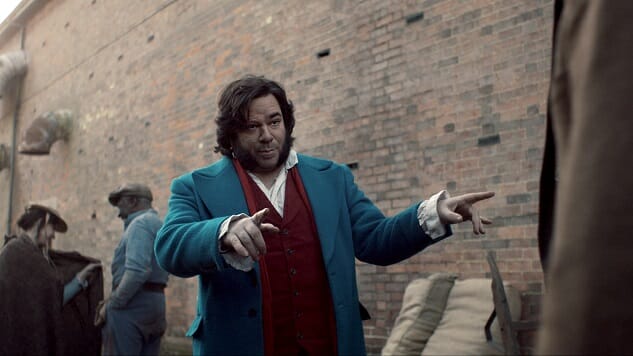Year of the Rabbit Is the Victorian Cop Comedy No One Asked For—But Thankfully Exists
Image courtesy of IFC
A few weeks ago, IFC renewed its new Victorian-era comedy series, Year of the Rabbit, for a second season. While the series had yet to premiere on the network yet at that point, it had already aired its first season (all six episodes) in its entirety on the UK’s Channel 4 last June. Renewal before a show even premieres is always somewhat of a unique show of confidence, but considering the fact that Year of the Rabbit is a comedy led by a unique brand of comedian in the form of Matt Berry—whose series Toast of London has also found an American home on IFC—this particular show of confidence makes a lot of sense. It makes even more sense once you’ve actually seen even a single episode of Year of the Rabbit.
Starring Berry as the eponymous Detective Inspector Eli Rabbit, Year of the Rabbit could be best described as one-third Dickensian satire, one-third procedural parody, and one-third, well, exactly the type of comedy (from the immature aspects to the surprisingly brilliant) that you’d expect from a contemporary Matt Berry starring vehicle.
When it comes to that last third component of the series, it’s worth noting that Year of the Rabbit is actually much more of an ensemble piece than something like Toast of London—which is also a large part of what makes it work as well as it does. While Rabbit is, in fact, the self-centered narcissistic blowhard one would expect from a Berry character, it’s surprisingly reined in here to allow the rest of the team to shine and to prop them up. Though, “reined in” doesn’t necessarily translate to Berry playing the straight man, considering how absurd everything in this show is, in general. As much as Berry certainly puts on his usual powerful performance as this type of character, it doesn’t overshadow the weirdness and the quirks of the other characters who follow him on this journey. Because Year of the Rabbit is full of weirdness and quirks at every densely-packed (and disease-ridden) corner.
Berry’s Rabbit is essentially a comedic take on the grizzled, booze-addled loner cop—right down to being saddled with a team he didn’t ask for—only placed within a Victorian London-era setting. That includes his green new partner in the form of the naive Detective Sergeant Wilbur Strauss (Freddie Fox) and aspiring lady cop—despite the fact that women obviously can’t be cops—Mabel Wisbech (Susan Wokoma), adopted daughter of Rabbit’s direct superior, Chief Inspector Hugh Wisbech (Alun Armstrong). (Race only comes up once in the show, and well… Things don’t work out for that one racist.) Rounding out the “team” is Gwendoline (Ann Mitchell), the owner of the local bar the team frequents and Rabbit’s closest friend and confidante. Challenging Rabbit and his team’s ability to do their jobs, however, are rival officer—with an intriguing backstory—Detective Inspector Tanner (Paul Strutter) and the series’ Big Bad, the mysterious Lydia (an unsurprisingly terrific Keeley Hawes).
Despite Rabbit’s lone wolf persona and “plays by his own rules” attitude, it’s amusing early on just how little pushback Rabbit actually goes through when it comes to the team dynamic. In fact, the trio of Rabbit, Strauss, and Mabel form a rather quick bond, which allows Year of the Rabbit to instead focus on the instant dynamics within this partnership: like Rabbit’s distrust and complete lack of understanding of any technological or scientific component, Strauss’ frustration with Rabbit constantly keeping things from him, Rabbit and Mabel’s mocking of Strauss’ poor taste in women, and how Mabel is woman, therefore, not cop material. As Wisbech even tells his daughter: “Females can’t be police, love! Because men already are. That’s logic.”
-

-

-

-

-

-

-

-

-

-

-

-

-

-

-

-

-

-

-

-

-

-

-

-

-

-

-

-

-

-

-

-

-

-

-

-

-

-

-

-








































